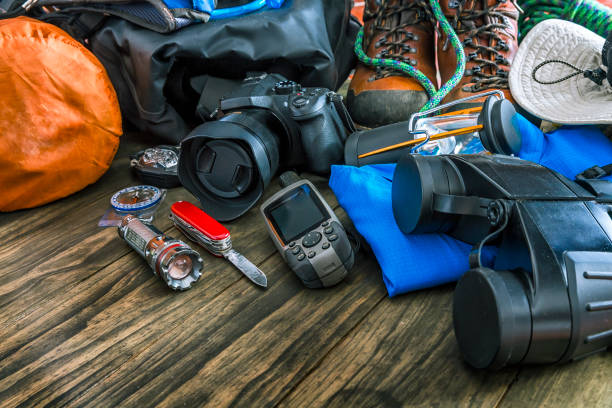
Camping equipment themes: Close-up of travel equipment and accessories for mountain camping and hiking on wooden floor
The great outdoors calls to everyone; the fresh air, open skies, and the freedom to explore nature’s beauty offer a powerful sense of renewal. For many, hiking, camping, or mountain biking are more than hobbies; they’re essential parts of a balanced, fulfilling life. However, for outdoor enthusiasts with health conditions, such adventures require additional planning and specialized tools to stay safe and confident in remote environments. Thankfully, technology has advanced to a point where staying connected, monitored, and prepared has never been easier.
Modern tech offers more than convenience; it provides peace of mind. Wearable sensors, portable medical devices, and smart emergency tools help travelers manage health risks while remaining fully immersed in nature. Even in areas without cell service, these technologies bridge the gap between independence and safety. For those living with conditions like diabetes, asthma, heart disease, or allergies, embracing the right tech essentials can make outdoor adventures safer and far more enjoyable.
Beyond basic fitness wearables, there are tools designed specifically for medical safety. A First responder QR medical tag, for example, is a small but powerful addition to any adventurer’s gear. It securely stores critical health and emergency contact information, allowing rescuers to access life-saving details even if the user is unconscious or unable to communicate. In an emergency, every second counts, and such technology ensures that help is informed and effective. When used alongside wearable monitors or smart devices, it creates a complete safety network for outdoor enthusiasts managing medical conditions.
Challenge: Managing Health in Remote Environments
Outdoor exploration presents a special set of challenges for people with ongoing medical conditions. Away from the conveniences of urban life, travelers face unpredictable terrain, extreme weather, and limited medical access. For someone who depends on daily medication, blood sugar checks, or heart monitoring, these challenges can quickly escalate into emergencies.
Moreover, outdoor adventures often mean unreliable communication signals. A sudden asthma flare-up, allergic reaction, or cardiac issue can become dangerous without access to immediate help. That’s why proactive preparation is essential. The right technology not only provides medical monitoring but also ensures you can be found and treated promptly if something goes wrong.
Smart Health and Safety Devices
The first layer of protection comes from wearable health technology. Devices like smartwatches and fitness bands have evolved beyond step counters; they now monitor oxygen levels, heart rate variability, and even irregular rhythms that could indicate cardiac distress. Many models automatically alert emergency contacts if abnormal patterns are detected.
For hikers and climbers, barometer sensors and altitude monitors help prevent altitude sickness by tracking atmospheric pressure changes. Meanwhile, continuous glucose monitors (CGMs) offer real-time feedback for individuals managing diabetes, displaying blood sugar levels through Bluetooth-connected apps.
These tools not only provide valuable insights but also empower users to take preventive action. The integration of AI-based health tracking allows for early detection of potential issues, making intervention faster and more effective, even in the middle of nowhere.
Emergency and Communication Tech
Reliable communication tools are vital for any outdoor adventure. Satellite messengers and personal locator beacons (PLBs) allow users to send SOS signals even in areas without cellular coverage. Many devices transmit GPS coordinates directly to emergency services, dramatically improving rescue response times.
Some advanced satellite communicators also allow for two-way text messaging, letting adventurers update family or medical professionals about their situation. Combining these tools with smart health tech provides an all-around safety net.
Solar-powered chargers and power banks ensure that essential devices remain functional during extended trips. Portable solar panels can recharge everything from GPS devices to smartwatches, making them indispensable for long-term expeditions.
Monitoring and Medical Support Tools
For travelers managing chronic conditions, portable medical tools are invaluable. Compact, battery-efficient devices like digital blood pressure monitors, pulse oximeters, and portable nebulizers provide on-the-go medical support. Many of these connect directly to smartphone apps for tracking and data sharing.
Smart medication management is another growing area of outdoor technology. Pill organizers with built-in alarms remind users when to take medication, even when offline. Apps can also log medication schedules and track symptoms, helping users maintain consistency.
Equally important are wearable medical identifiers like QR-enabled wristbands or patches that allow quick access to personal health data. These identifiers can connect emergency responders to critical information, including allergies, medication lists, and contact details, improving care efficiency in remote situations.
Choosing Reliable Tech for the Outdoors
When selecting devices for outdoor travel, reliability and durability come first. Devices must withstand weather changes, drops, and moisture. Look for waterproof or rugged-certified equipment designed for outdoor environments. Long battery life is also essential many devices now offer low-power or emergency modes to extend usability.
Ease of use is another major factor. In high-stress situations, simplicity saves time. Devices with clear displays, tactile buttons, or voice commands work better in cold or low-visibility conditions. Accessibility features such as audio alerts or vibration feedback are especially valuable for users with sensory challenges.
Lastly, consider compatibility. Some devices sync seamlessly, allowing users to monitor all their data from a single app. Integrating medical data, GPS tracking, and communication alerts into one system enhances convenience and safety.
Health and Safety Apps for Outdoor Enthusiasts
In addition to hardware, software plays an essential role in health management. Apps designed for outdoor safety offer real-time weather alerts, navigation guidance, and SOS functionality. Some applications even download offline maps for areas with no internet coverage.
For those managing health conditions, specialized apps track vital signs, medication schedules, and physical activity. Many sync with wearable devices to compile comprehensive health reports. These tools allow adventurers to stay informed and proactive, ensuring that potential health risks are detected early.
Mental well-being apps are also beneficial for outdoor travelers. Guided breathing and mindfulness tools can help manage anxiety or panic attacks during stressful moments in remote environments.
Tips for Safe and Enjoyable Adventures
Preparation extends beyond packing technology. Always test your devices before leaving home. Ensure batteries are charged, software is updated, and you know how each feature works.
Share your trip plan with someone you trust, including routes, rest stops, and return times. Carry backup navigation tools such as a map and compass, even if you rely on GPS.
Pack enough medication for the entire trip, plus a few extra days. Store it in waterproof containers and note dosage instructions clearly. Additionally, stay hydrated, rest frequently, and listen to your body’s signals. Technology enhances safety, but self-awareness remains the most valuable skill in the wild.
Embracing Technology as a Safety Partner
Technology should enhance, not overshadow, the outdoor experience. The goal is to balance safety with freedom. By integrating wearable health monitors, smart communication devices, and portable medical tools, outdoor enthusiasts can confidently explore without unnecessary risk.
Tech innovations now allow people with health conditions to pursue their passions fully, rather than limiting their adventures due to safety concerns. Whether trekking through forests, scaling peaks, or camping off the grid, these tools act as silent guardians always ready to help when needed most.
Conclusion
Exploring nature with health conditions once meant constant worry about emergencies or limited access to help. Today, technology has changed that reality. From health-tracking wearables to smart emergency tools, outdoor enthusiasts can enjoy independence while maintaining safety.
Investing in reliable tech essentials ensures peace of mind, reduces risk, and fosters confidence in every journey. As innovation continues to evolve, adventure and health no longer need to be separate. With the right preparation and smart tools, everyone, regardless of medical background, can experience the joy of the outdoors safely and fully


